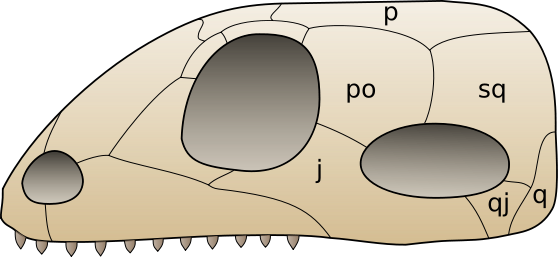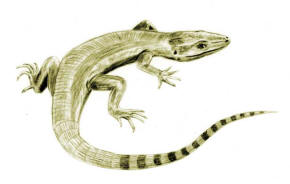Synapsids were the dominant
terrestrial animals in the middle to late
Permian
period. As with almost all groups then extant, their numbers and variety
were severely reduced by the
Permian extinction. Some species survived into the
Triassic
period, but
archosaurs quickly became the dominant animals and few of the
non-mammalian synapsids outlasted the Triassic, although survivors persisted
into the
Cretaceous. However, they included the prehistoric ancestors of mammals
and in this sense, synapsids are still very much a living class of
vertebrates. Synapsids, most recently and notably
humans, again became the dominant land animals after they outcompeted
birds following the
K-T extinction event.
Pelycosaur
The pelycosaurs (from Greek πέλυξ - pelyx
"axe" or perhaps "bowl"/"pelvis" and σαῦρος sauros "lizard") were
primitive Late Paleozoic synapsid
amniotes. Some species were quite large and could grow up to 3 meters or
more, although most species were much smaller.
Archaeothyris and
Clepsydrops are the earliest known synapsids.
They lived in the
Pennsylvanian subperiod of the
Carboniferous Period and belonged to the series of primitive synapsids
which are conventionally grouped as pelycosaurs. The pelycosaurs were the
first successful group of
amniotes,
spreading and diversifying until they became the dominant large terrestrial
animals in the latest Carboniferous and Early
Permian
Periods. They were sprawling, bulky,
cold-blooded and had
small brains. They were the largest land animals of their time, ranging up
to 3 m (10 ft) in length. The pelycosaurs appeared during the
Late
Carboniferous and reached their acme in the
early part of the Permian
Period, remaining the dominant land animals for some 40 million years. A
few continued into the
late Permian. They were succeeded by the
therapsids.
At least two pelycosaur
clades independently
evolved a tall sail, consisting of elongated vertebral spines: the
edaphosaurids and the
sphenacodontids. In
life, this would have been covered by skin, and possibly functioned as a
thermoregulatory device
and/or for mating display. Pelycosaur fossils have been found mainly in
Europe and North America, although
some small, late-surviving forms are known from Russia and South Africa.
Unlike
lepidosaurian reptiles,
pelycosaurs lacked epidermal
scales. Fossil evidence
from some ophiacodonts shows that parts of the skin was naked, but that the
belly was covered in dermal
scutes, looking like
the scutes present in other reptile groups, which are of a different type of
structure.
Dermal scutes are also found in
extant mammals, in the tails of
rats,
beavers and
Opossum, and as regular
dermal armour with underlying bone in the
armadillo.
End of Lesson
Return to the
Old Earth Ministries Online Earth
History Curriculum homepage.


